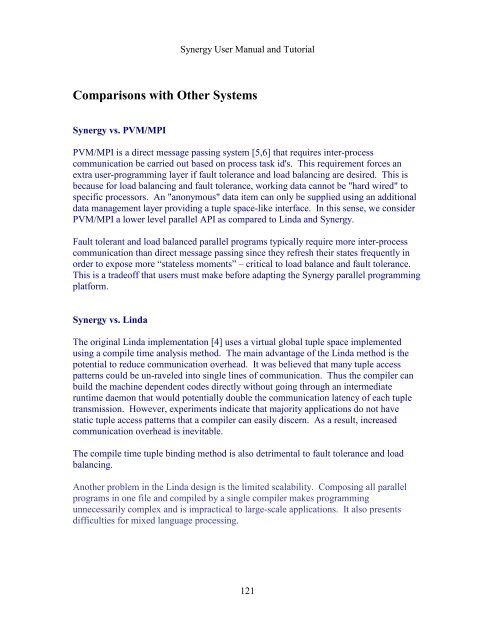Synergy User Manual and Tutorial. - THE CORE MEMORY
Synergy User Manual and Tutorial. - THE CORE MEMORY
Synergy User Manual and Tutorial. - THE CORE MEMORY
Create successful ePaper yourself
Turn your PDF publications into a flip-book with our unique Google optimized e-Paper software.
<strong>Synergy</strong> <strong>User</strong> <strong>Manual</strong> <strong>and</strong> <strong>Tutorial</strong><br />
Comparisons with Other Systems<br />
<strong>Synergy</strong> vs. PVM/MPI<br />
PVM/MPI is a direct message passing system [5,6] that requires inter-process<br />
communication be carried out based on process task id's. This requirement forces an<br />
extra user-programming layer if fault tolerance <strong>and</strong> load balancing are desired. This is<br />
because for load balancing <strong>and</strong> fault tolerance, working data cannot be "hard wired" to<br />
specific processors. An "anonymous" data item can only be supplied using an additional<br />
data management layer providing a tuple space-like interface. In this sense, we consider<br />
PVM/MPI a lower level parallel API as compared to Linda <strong>and</strong> <strong>Synergy</strong>.<br />
Fault tolerant <strong>and</strong> load balanced parallel programs typically require more inter-process<br />
communication than direct message passing since they refresh their states frequently in<br />
order to expose more “stateless moments” – critical to load balance <strong>and</strong> fault tolerance.<br />
This is a tradeoff that users must make before adapting the <strong>Synergy</strong> parallel programming<br />
platform.<br />
<strong>Synergy</strong> vs. Linda<br />
The original Linda implementation [4] uses a virtual global tuple space implemented<br />
using a compile time analysis method. The main advantage of the Linda method is the<br />
potential to reduce communication overhead. It was believed that many tuple access<br />
patterns could be un-raveled into single lines of communication. Thus the compiler can<br />
build the machine dependent codes directly without going through an intermediate<br />
runtime daemon that would potentially double the communication latency of each tuple<br />
transmission. However, experiments indicate that majority applications do not have<br />
static tuple access patterns that a compiler can easily discern. As a result, increased<br />
communication overhead is inevitable.<br />
The compile time tuple binding method is also detrimental to fault tolerance <strong>and</strong> load<br />
balancing.<br />
Another problem in the Linda design is the limited scalability. Composing all parallel<br />
programs in one file <strong>and</strong> compiled by a single compiler makes programming<br />
unnecessarily complex <strong>and</strong> is impractical to large-scale applications. It also presents<br />
difficulties for mixed language processing.<br />
121

















